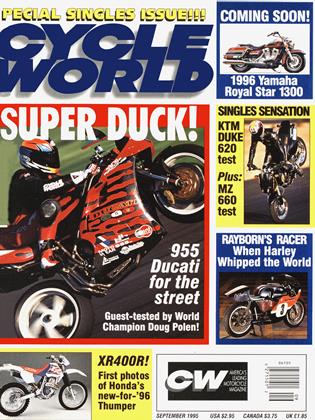1996 HONDA XR400R
WHEN RUMORS COME TRUE
FOR YEARS THE SPECULATION HAS SWIRLED—HONDA HAS a lightweight, 400cc Thumper in the works, a best-of-both-worlds dirtbike with the agility of a 250 and the rock-chucking punch of a 600. And for years disappointed off-road four-stroke fans had to be content with the promise of next year.
Well, next year is here.
A tip-off was the introduction in Japan in late 1994 of an all-new XR250. The new-for-’96 XR400R follows that bike's blueprints very closely. Its 397cc air-cooled engine has the same radial four-valve combustion-chamber design that has been with the XR line since 1984, but is otherwise all-new. An 85 x 70mm bore and stroke is said to provide the most free-revving power of all the combinations tried, yielding strong lowand midrange pull while still having plenty of over-rev. A dry-sump design keeps the oil out of the motor and in the cooler areas of the frame and headsetmounted oil-cooler.
Looks-wise, the motor appears traditionally XR. Sizewise, it is a bit smaller than an XR600 motor and utilizes a swingarm-pivot shaft on the rear of the engine cases, eliminating an extra mounting point. Its weight is 15.2 pounds less than the XR600 motor. Shared with the 600 is a cammounted automatic decompression release for easy starting, as well as a handlebar-mounted manual lever. Internally, the designs of the shifting mechanism and gearshafts are entirely new to the XR line, aimed at smoothing out shifting action. A two-piece clutch cover makes accessing the plates a 10-minute job.
Carburetion is handled with a 36mm piston-valve Keihin carb. The muflier is a compact and lighter design than on pre-
vious XRs, using repackable fiberglass wool instead of baffling chambers. It incorporates a screen-type spark arrestor.
The chassis is all-new and shares style with the XR250R. It has new rectangular downtubes to gain rigidity while keeping the weight to a minimum. Rake is 25 degrees, trail 56.1 mches-a degree more and an inch longer than the new 250. A removable rear subframe is incorporated into the design. The rear shock is accessed by the removal of three bolts, a couple of clamps and the taillight wire-simple in comparison to older XRs.
The 400’s shock and fork are top-flight Showa components fully adjustable for both compression and rebound damping. The fork is a new “hybrid” type, similar to the one found on the company's CBR900RR sportbike. This uses a two-piece lower leg that allows the use of lighter extruded tubing that is bonded into a cast-aluminum axle clamp. The advantage of the double-clamp is increased rigidity and less overhang -excess overhang is a drawback common to conventional forks. There arc 18 positions of compression damping, 12 of rebound, and 1 1 inches of travel. The piggyback shock has 16 clicks of compression and rebound, as well as spring-preload adjustment. It yields 11.8 inches of travel through a redesigned Pro-Link system that now incorporates an aluminum swingarm.
A new slim and trim profile will make the old XR600 seem bulbulous by comparison. Seat height is 36.6 inches, an inch lower than the 600. The 2.4-gallon gas tank is said to be good for at least 60 miles. Rolled onto a certified scale, the XR400 was weighed at 263 pounds. 2 pounds more than claimed, but still a good 22 pounds under the XR600.
How will the 400 perform on the trail? We'll have to wait for our test unit to arrive, but development riders only had praise for the new bike. Suspension settings were developed around the “aggressive” American rider. Combine this with the rigid new chassis and we're expecting performance unheard of in XR history. Power-wise, the 400 is not going to take the 600 in a highspeed dry-lake run, but under acceleration the 400 is said to pull much harder than the bigger XR.
So, if the XR400R was such a jolly good idea, why did Honda make us wait so long before introducing it? Blame it on history. For the past four years, Honda R&D has had its hands full trying to live down the legacy of the XR350. Last built in 1986. the midi-XR was a good bike that failed at the time to find a large audience. Corporate planners have long memories, and the image of XR35()s stacked to the ceiling in warehouses lingered on. So. too. did having to resort to blowout prices-S 1800 for a brand-new 350 in 1987-to move the product.
We're guessing that won’t happen this time. In fact, there may not be enough XR400Rs to go around. Honda’s market research shows that this bike is its single most-asked-for dirtbike ever. Customer demand appears to be there.
The build-philosophy behind the XR should help. It was conservative and cost-conscious-to refine existing XR technology, to be simple yet meet the consumer demands. Yes, liquid-cooling, perimeter frames and inverted forks were considered, but the arrived-at-packagc offers the performance Honda sought without the additional expense involved in flashy features. Given the weakened state of the dollar against the yen, it seems the philosophy was a good one.
Prices have not been set. but it is expected that the 400 will come in just a bit under the 1996 XR600. If so, expect to lay down just less than $5000 for your new XR400R. E3
 View Full Issue
View Full Issue
More From This Issue
-
 Up Front
Up FrontSingle-Minded
September 1995 By David Edwards -
 Leanings
LeaningsThe Bikes of Lago Di Como
September 1995 By Peter Egan -
 TDC
TDCIllusion, Disillusion
September 1995 By Kevin Cameron -
 Departments
DepartmentsLetters
September 1995 -
 Roundup
RoundupNew 900ss Ducks On the Way
September 1995 -
 Roundup
RoundupThree's A Charm For Ducati-Ferrari
September 1995




